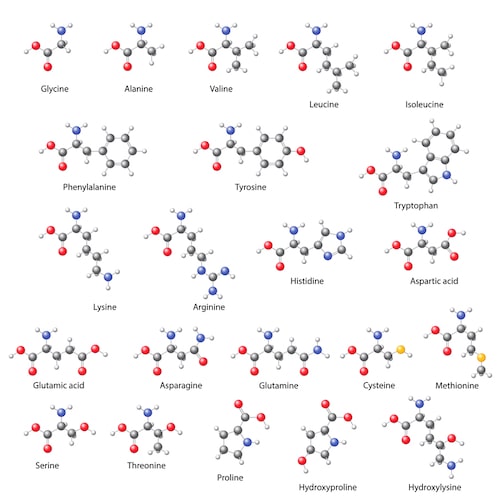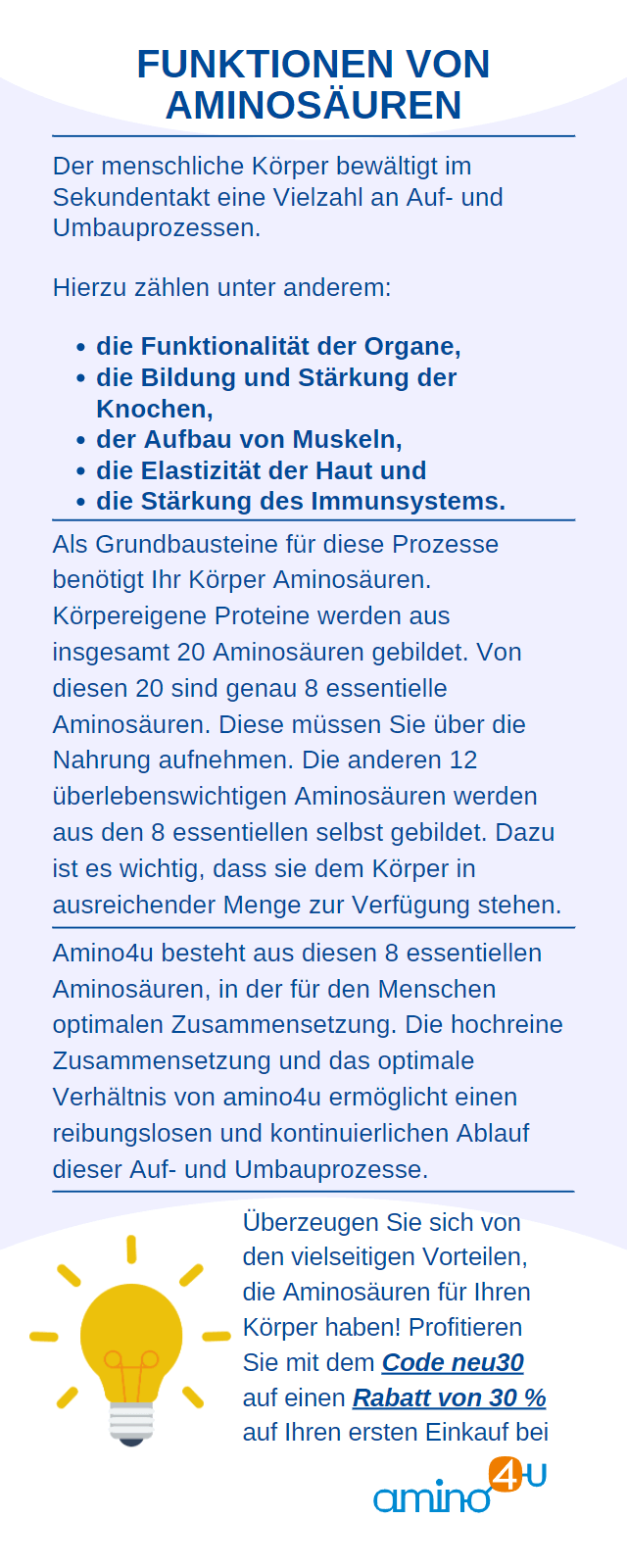Proteins are the building blocks of the human organism and are essential for building body proteins. This is where the proteinogenic amino acids come into play. They actively produce proteins in our bodies and are anchored in our genetic makeup.
In the specialist literature, proteins are often viewed as natural macromolecules . They themselves need proteinogenic amino acids as building blocks. In this article we will show you how important and diverse these amino acids are as a crucial building material for proteins .
Proteinogenic amino acids: chemical peculiarities as distinguishing features
A distinction is made between non-proteinogenic amino acids and proteinogenic amino acids .
Over 250 non-proteinogenic amino acids occur in our organism, although these cannot be detected in proteins. That is why they are considered non-protein-forming or non-proteinogenic.
The 22 so-called proteinogenic amino acids can produce proteins . In this regard, they are used in protein synthesis . Our body can produce most of these proteinogenic amino acids itself, but we have to supply the others.
The differences between the two are particularly evident in their respective chemical characteristics. In addition, proteins have different structural structures.
Proteinogenic amino acids are all linked together. This is a special form of bonding known as a peptide bond . This special bond can arise because every acid in this form contains both an amino group and a carboxyl group (organic compounds).

Proteinogenic amino acids at a glance
A total of 21 proteinogenic amino acid variants are now known. The individual proteinogenic acids are divided into four categories:
1. Polar side chains
From a chemical perspective, there is an uneven distribution of charge in the molecules. From a medical perspective, polar side chains determine the orientation of cells.
The following amino acids can be classified into this proteinogenic subgroup:
| amino acid | code | chemical code | Remark/Function |
| Asparagine | Asn | N | non-essential, starting substance for the formation of non-essential amino acids |
| Cysteine | Cys | C | non-essential, partly responsible for the formation of skin, hair, nails and bones |
| Glutamine | Eq | Q | non-essential, regulates water retention in the cells |
| Selenocysteine | Sec | U | non-essential, enables other amino acids to function (not yet fully researched) |
| Serine | Ser | S | non-essential, partially responsible for the transmission of stimuli from neurons in the brain |
| Threonine | Thr | T | essential, important building block for the formation of antibodies and defense reactions in the amino acid immune system |
| Tyrosine | Tyr | Y | non-essential, necessary for cell and body growth, can increase performance |
2. Non-polar side chains
An amino acid from this group gives a protein hydrophobic (water-insoluble) properties. This means that proteins are not soluble in water, but in most cases they are easily soluble in oil and fat. In this context, lipophilia is also spoken of.
The following amino acids can be classified into this proteinogenic subgroup:
| amino acid | code | chemical code | Remark/Function |
| Alanine | Alas | A | non-essential, energy supplier that regulates blood sugar levels |
| Glycine | Gly | G | non-essential, acts as a neurotransmitter in the central nervous system |
| Isoleucine | Ile | I | essential, responsible for muscle regeneration, muscle building and mass gain |
| Leucine | Leu | L | essential, necessary for building tissue, inhibits muscle breakdown, promotes healing processes |
| Methionine | Met | M | essential, contains sulfur, inhibits the growth of bacteria |
| Proline | Per | P | non-essential, building block of connective tissue, bones and cartilage |
| Phenylalanine | Phe | F | essential, responsible for building muscle and producing hormones |
| Tryptophan | Trp | W | essential |
| Valine | Val | v | essential, important for muscle maintenance, regulates blood sugar, source of energy |
3. Basic side chains
The amino acid versions of arginine, histidine and lysine fit into this category. They have a so-called proton acceptor - i.e. a base - in the side chains and react basicly in solutions. They usually have an additional amino group.
| amino acid | code | chemical code | Remark/Function |
| Arginine | Arg | R | semi-essential, neurotransmitter in the central nervous system, responsible for the functionality of memory in learning, formation of sperm |
| histidine | His | H | semi-essential, responsible for oxygen transport in the body |
| Lysine | Lys | K | essential, involved in many body processes such as muscle building, cell division, bone growth, wound healing |
4. Acidic side chains
In this subgroup there are only two proteinogenic amino acid versions : aspartate and glutamate . A special feature of these two acids is the proton donor present in the structure. This is a special substance that can transfer protons to an acid with a corresponding proton acceptor. This process is called protolysis.
| amino acid | code | chemical code | Remark/Function |
| Aspartate | Asp | D | semi-essential, building block for the formation of non-essential amino acids |
| Glutamate | Glu | E | non-essential, involved in the formation of proteins |

Proteins differ in their shape
There are different types of proteins in this regard. What is particularly striking is the diversity and the different areas of responsibility .
- Structural proteins can be found in all cell compartments. This is the name of the different spaces in a cell. They serve as building materials in cells and tissues.
- Motor proteins ensure the intracellular transport of vesicles , which are important components for many processes within the cells.
- The so-called signaling proteins transmit and receive information. These signals are transmitted to the cell nucleus by the cell membrane receptors .
- Enzyme proteins are also very important for the human organism. These act as a kind of biological catalyst and ensure smooth energy and building material metabolism.
- In addition, the so-called transport and storage proteins bind oxygen . This type of protein then transports oxygen exactly where it is needed.
Amino acid sequence - individual blueprint for proteins
A proteinogenic amino acid is an organic carboxylic acid that has at least one amino group. Since the proteinogenic amino acid is responsible for building proteins, there is an extremely high biological relevance here. In terms of structure, proteins consist of amino acid building blocks that are peptidically linked to one another and have sequences of different lengths. This particular composition is called an amino acid sequence .
The sequence represents an individual characteristic for each individual protein, which acts as a personal blueprint. The number of linked amino acid building blocks varies from protein to protein. Some have more than a hundred building blocks, while other proteins can even consist of over 1,000 amino acid building blocks. The muscle protein titin, with its around 30,000 building blocks, is considered the longest known protein. The present amino acid sequence is correspondingly complex.

Proteinogenic amino acids that your body does not produce
If the proteinogenic amino acids are not produced independently by the human body in sufficient quantities or not at all, a need arises. This is balanced out by consuming the respective building blocks through food or amino acid supplements . There are differences between essential and semi-essential amino acids .
Your body cannot produce the following eight acids itself. These are therefore called essential amino acids . Scientists and doctors have clearly defined what amounts of a proteinogenic amino acid should be supplied to the body.
The values are always to be understood per kilogram of body weight and per day:
- Leucine: 10 to 50 milligrams (mg)
- Isoleucine: 20 mg
- Lysine: 30 to 64 mg
- Phenylalanine: 38 to 52 mg
- Threonine: 16 mg
- Tryptophan: 4 mg
- Methionine: 21 mg
- Valine: 26 mg
Semi-essential & proteinogenic amino acids: arginine and histidine
In contrast, arginine and histidine are semi-essential variants of the amino acid. The body does synthesize these substances, but under certain circumstances not to a sufficient extent. Therefore, you should also consume these substances, which are important for building proteins, through your diet. As you get older, the importance of these proteinogenic components for cell structure and therefore for your body increases.
They act as important tools for combating or curbing stress and certain illnesses. They also play a crucial role in targeted muscle building and muscle maintenance. The recommended daily amount per kilogram of body weight for arginine is between one and five grams. For histidine, ten grams are specified.
Protein unfolding is not automatically assured
The charge (positive or negative) plays an important role when dividing into groups. The size and hydrophobicity are also important. It has been shown experimentally that not all amino acid variants defined as proteinogenic are really important for functional and reliable protein unfolding. This becomes clear just from what happened during evolution. At the beginning of the evolutionary chain, acids such as alanine and glycine first appeared.
These are extremely simple acids. Only later were the complexly structured, aromatic amino acid variants added. Analyzes of the structures suggest that tyrosine and tryptophan, for example, slipped into the genetic code very late. And only after the lineages had already branched out.
Proteinogenic amino acids are involved in the formation of several substances in the body
As already shown, amino acids identified as proteinogenic represent important building blocks for proteins. These in turn are responsible for the formation and renewal of body cells. In addition, the acids help to cover the required energy requirements as part of various processes in the body or organism. Some of the proteinogenic acids serve as messenger substances in the nervous system.
As a starting substance, many amino acids are involved in the formation of important substances such as messenger substances or hormones in the human body. Don't forget the positive influence on ornithine, y-aminobutyric acid and similar substances. If necessary, these amino acid variants are formed directly from the acids defined as proteinogenic.
Also used in the food industry
To a small extent, proteinogenic acid versions are also contained as so-called free amino acids in a large number of different foods. The substances have a lasting influence on the taste. A typical example of such a scenario is the use of the special amino acid glutamine.
The tasteless amino acid enhances the taste of dishes and dishes through its own substance glutamate. An amino acid used in this form is irrelevant for protein construction or for the formation of other substances.
We hope that our article gave you an overview of the functions and meanings of proteinogenic amino acids and that we were able to give you a little more insight into their use.Try it out for yourself and convince yourself of our amino acid effect .




